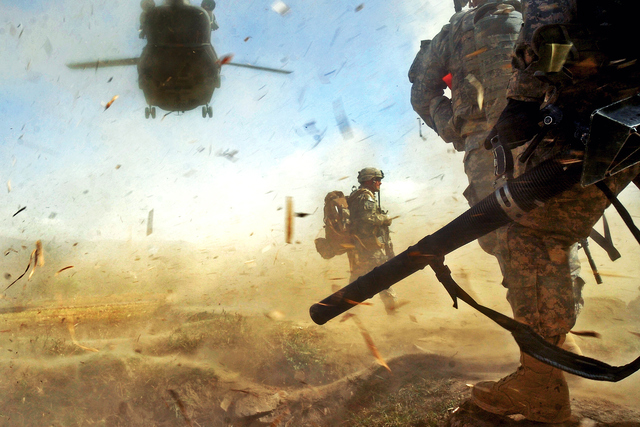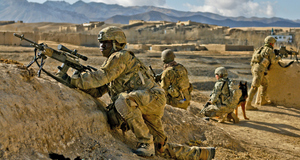From Nostalgia to Post-Traumatic Stress Disorder: A Mass Society Theory of Psychological Reactions to Combat
By
2013, Vol. 5 No. 02 | pg. 1/3 | »
IN THIS ARTICLE
KEYWORDS
AbstractThis paper analyzes the evolution of the construct known as Post-Traumatic Stress Disorder. Specifically, it examines the ways in which its name has changed over millennia and how soldiers suffering from this mental condition were treated by society during different eras of human history up until it was accepted by the mental health community in 1980. Moreover, it identifies certain social factors that have influenced public perception of the disorder through the application of mass society theory. In some respects, its analysis bears resemblance to Foucault’s (1961/1965) examination of insanity and conveys that changes in culture are illustrative of changes in social structure. It is important to understand how soldiers suffering from Post-Traumatic Stress Disorder are perceived in order to ascertain the proper role of society and government in the treatment and re-assimilation of the current generation of veterans. The construct now known as Post-Traumatic Stress Disorder (PTSD) has been a recognized consequence of war for at least as long as historians have been documenting conflicts. Though, the current generation of Operation Enduring Freedom (OEF) and Operation Iraqi Freedom (OIF) veterans does not regard it with as much stigmatization as did those of past wars. Today, those who return from the battlefield generally do not feel as though they are “crazy” or marginalized. Instead, they are at least partially relieved to know that the problem can be identified and that the recovery process may begin. However, there is significant difference today in how the disorder is perceived by the military and civilian communities. Though unknown to most outside of the ranks of professional war-fighters, PTSD has been with man throughout the ages in many forms. Scholars, poets, and playwrights have chronicled its symptoms in some of the world’s most ancient writings, including religious texts, epic poems, and battlefield narratives. First officially identified by Western clinicians in the 17th Century, its moniker has changed repeatedly to reflect public perceptions of the afflicted. The purpose of this paper is to examine how social factors have influenced shifts in civilians’ cognitive representations of those who suffer from PTSD and how they have been treated by their government.PTSD is an example of how personal troubles are inextricably linked to social problems. This very intimate disorder is the byproduct of a collective decision, or at least the initial majority acceptance of such a decision, to send young members of a society to war. Accordingly, Catherall (1986) championed a social healing process intended to be included as part of the treatment regimen for PTSD. She proposed incorporating social interaction treatment in order to expedite the re-assimilation of patients into society. Paratroopers prepare to load a CH-47 Chinook Helicopter in the Bermel District of the Paktika province in eastern Afghanistan, Oct. 13, during an air-assault mission to detain a known militant. Photo: U.S. Army/Pfc. Andrya Hill CC-2 The archaic Ships of Fools mentality contended that psychologically damaged persons were somehow different and therefore should be excluded from the group (Foucault, 1961/1965, pp. vi-vii). However, this state of affairs says more about the nature of the society than the afflicted. Gradually, mental health professionals have grown to understand that this method is wholly ineffective and serves only to stigmatize. Nevertheless, there are still several social barriers which prevent veterans from seeking treatment for PTSD; not the least of which are uninformed notions of “weakness” and machismo. These beliefs and values interrupt the healing process and further marginalize ailing veterans. Accordingly, it is necessary to investigate the origins and development of these values in order to discern the proper place of veterans suffering from PTSD within contemporary American society. Mass Society TheoryMass society theory holds that traditional societies are gradually developing into mass societies, characterized by impersonal social relationship indicative of weakening solidarity (Harper & Leicht, 2011, p. 49). It contends that innovations, particularly technological advances in transport and communications, have brought people together like never before and that the division / specialization of labor have made them more dependent upon one another. However, despite the interdependence, they have grown more estranged as the traditional group ties of family and community are virtually non-existent. Consequently, mores and norms become more flexible and there are few, if any, truly unifying values. This is undoubtedly especially true in the constitutional democracy of the United States wherein individuality is quite often celebrated. Each individual must assume a multiplicity of roles because there is no fixed concept of status. The resultant confusion causes persons to lose their sense of self and conjures anxiety. A society such as this is tantamount to a cinema theater filled with detached anonymous patrons; individuals detached even from themselves (Bell, 1956). Due to the combination of time spent removed from the rest of society and anxiety-based reactions to combat, veterans may find it particularly difficult to form social bonds under these circumstances. The terminology used to label psychological reactions to combat has evolved from “nostalgia” and “soldier’s heart” to the more impersonal “combat exhaustion” and PTSD. The more recent sobriquets appear to be demonstrably more sterilized and void of humanity (Trimble, 1985). This sort of euphemistic language serves to socially distance observers from the sentient humans who are afflicted with the disorder. The malady becomes perceived as one confined to a select vocation, that of soldier, and therefore solely within the purview of the federal government’s ever-expanding duties; which are being increasingly augmented by the efforts of non-profit organizations as people begin to question the competency of their governors. Any individual or communal responsibility for the treatment of an afflicted veteran appears to be deflected and redirected into the realms of politics and philanthropy. Yellow ribbons and wreaths across America honor an abstract notion of nationalism and sacrifice, not individual troops. The people revere symbols rather than faces and names. Most notably, stopping however briefly to praise these artifacts shields the observer from the guilt associated with inaction. They may praise a martyr, though being confronted with the presence of someone who has returned alive but damaged is often too uncomfortable. Mass society theory shares a common foundation with the Marxian school of thought. The prevalence of PTSD among veterans is illustrative of an inherent scarcity of resources as explained through the conflict perspective. Incidentally, only a very small percentage of the American population is likely to suffer no negative behavioral symptoms following an armed conflict; sociopaths, psychopaths, and other afflicted persons who are largely discouraged from entering into military service in the first instance. Importantly, this is due to the fact that characteristics such as psychopathy can be viewed as an evolved life strategy from a socio-biological standpoint. Therefore, the percentage of such individuals within any given society must remain below a certain threshold, lest group cohesion completely deteriorate (Mokros et al., 2008). However, American society still regards war as often necessary, even though human beings share an otherwise useful and natural revulsion against harming members of their own species (Hamblen, 2009). Since it would appear that the majority of soldiers enter into war mostly sane, the issue then becomes a question of recompense and access to treatment. As is most anything of value, these resources are also scarce; hence there has been an historic apprehension by the military and federal government to accept PTSD as a legitimate byproduct of war and offer care to veterans. For the most part, a different crop of soldiers fights in each new war, each war is perceived and justified differently by the public, and veterans of previous conflicts generally do not strictly align themselves with those currently fighting. For example, many veterans’ groups distinguish themselves based upon campaign or whether or not a member actually experienced combat. The veteran demographic is therefore one of myriad occasionally overlapping loyalties. For example, a 20-something returning from Afghanistan ready to enroll in college under the new Post-9/11 G.I. Bill may find little in common personally and politically with a World War II veteran receiving Medicare. Importantly, the respective concerns of each of these groups are very much dependent upon how “their” war was perceived by the public. For instance, World War II-era veterans, roughly one-third of the then national male population over age 15, were heralded as the Greatest Generation (Department of Veterans Affairs, 2004). Contrarily, the U.S. involvement in Korea has been colloquially dubbed the Forgotten War and Vietnam veterans struggled for decades before the engagement was “upgraded” from conflict to war. Veterans of OEF/OIF will likely enjoy a more modest version of the appreciation shown to their WWII-era counterparts. If for no other reason, this is attributable to the fact that, like the Second World War, the Global War on Terror was at least initially perceived by most Americans to be an act of reactive self-defense, rather than an intrusive peace-keeping or stability operation. This was obviously not the case during the nation’s several decades spent combatting the spread of Communism. In some ways, this is illustrative of a pluralized conflict as soldiers have served in a plethora of often unrelated conflicts, generally separated by years of peace (Harper & Leicht, 2011, p. 54). Consequently, the changes in perception of PTSD have been slow and piecemeal. Mass Society Theory and PTSD Across TimeThe current place of the veteran in American society is unique to these times. In his famous essay, retired Army Lieutenant Colonel and Professor of Military Science Dave Grossman (2000) explained the relationship between what he perceived as the three major social roles assumed by individuals relative to safety and security; sheep, wolves, and sheepdogs. Therein, the majority of people are sheep. They are gentle, unassuming, and could only harm another by accident or under extreme provocation. Contrarily, the wolves prey on the sheep without mercy. Therefore, it is the duty of the sheepdogs to protect the flock. However, the sheepdog looks very similar to the wolf; which does not go unnoticed by the sheep. He has fangs and is capable of visiting violence upon others. This frightens the sheep. They shun the sheepdog because he does not belong. Yet, when the wolves come, the sheep rally behind the sheepdog. In a more narrow sense than Grossman intended, veterans represent the sheepdogs of our society. More importantly, they remind the populace of the unpleasantness endured by some so that the many may prosper; the thin blue shell that protects the delicate life inside the robin’s egg. Therefore, the veteran is socially isolated. This is particularly true if he or she suffers from a visible or invisible injury that may remind the sheep of the atrocity of war. Fortunately, the historical and anecdotal data is sufficient to paint a longitudinal picture of how Western, specifically American, civilization evolved (or perhaps degenerated) into a mass society and illustrate what impact this has had on returning warriors. In Mythology and Ancient History through the RenaissanceEmotional responses to trauma have been documented in some of the most ancient religious texts, allegories, and moral lessons. For example, the compilation of Indian mythology called the Mahabharata chronicles a great war said to have taken place in 3139 BCE. It contains graphic depictions of numerous battles and described vivid combat stress reactions displayed by the warrior characters (Jayatunge, 2012). Similarly, the Buddhist Jataka stories, compiled between the 3rd Century BCE and 5th Century CE, contain some of history’s oldest fables. Throughout these tales, numerous characters conveyed symptoms consistent with PTSD; such as a monk who suffered from hyper-vigilance, avoidance, and emotional detachment (Davids, 1880). To Westerners, the Book of Job is the Holy Bible details what is perhaps the most well-known account of human suffering. The story portrays a man who endured a gauntlet of psychological stressors and disappointment in order to highlight the resilience of the human spirit; within the framework of what Carl Jung (1952/2010) would later term the “divine drama.” Subsequently, researchers have contended that Job’s mental anguish and reactions were comparable in many respects to the symptoms often observed in people suffering from PTSD (Haughn & Gonsiorek, 2009). Some of the most prominent works of classical literature are permeated with references to the psychological and emotional impact of combat. Perhaps most poetically, Homer’s (730 BCE / 1998) epic, The Iliad, provides intimate accounts of battles stress, the most notable of which are the lamentations of survivor’s guilt proclaimed by the archetypical warrior Achilles following the death and desecration of his friend Patroclus (p. 270). Homer also described the curious actions of Ajax, who went mad under Athena’s spell and slaughtered an entire herd of sheep that he mistook for the enemy before ultimately killing himself (p. 303). Notably, the poem uniquely presented the agony of separation endured by the Trojan women while their husbands, brothers, and sons were embattled. Undoubtedly, future poets and playwrights were influenced by this image of military wives and war widows as indirect victims of armed conflict. This is especially evident in the pleas of a soldier’s wife taken from Shakespeare’s (1597 / 2010) Henry IV, Part I: “In thy faint slumbers I by thee have watched, and heard thee murmur tales of iron wars…Thy spirit within thee hath been so at war and thus hath so bestirred thee in thy sleep” (Act II, Scene III). Written over four centuries ago without the insight of even rudimentary psychiatric knowledge, these lines infer the onslaught of symptoms such as sleep disturbance and flashback dreams. It is also axiomatic in the dialogue throughout this scene that the soldier suffers from social withdrawal, depression, and problems with intimacy. Ultimately, his wife reasons that if he does not care enough to tell her what troubles him, he must not love her. Surely today, some veterans’ wives cry similar pleas into the night.Continued on Next Page » Suggested Reading from Inquiries Journal
Inquiries Journal provides undergraduate and graduate students around the world a platform for the wide dissemination of academic work over a range of core disciplines. Representing the work of students from hundreds of institutions around the globe, Inquiries Journal's large database of academic articles is completely free. Learn more | Blog | Submit Latest in Sociology |

















